
It's been 10 years since United States-led forces waged war in Iraq. In this collection of some of the defining Reuters images from the conflict, the photographers also provide a personal account of the events they captured.
In this photograph, a barefoot Iraqi man is detained by soldiers of US Army's 4th Infantry Division during a raid in the suburb of Baquba on November 9, 2003.
US troops raided several houses in Baquba late afternoon looking for members of suspected terrorist cell planning attacks on coalition forces.
Photojournalist Damir Sagoli later writes, "Contrary to this man who was detained and later brought to the base -- what happened to him after I don't know -- for us it was just another ugly day that it could have turned even more ugly if something went wrong. What I do remember is one petty officer during this operation in Baquba -- I remember his cheap fake teeth, old fashioned mustaches and how brutal he was with Iraqis that were captured that day."
Please click NEXT for More...
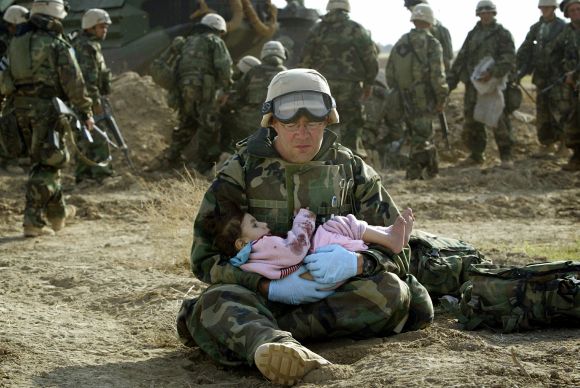
US Navy Hospital Corpsman HM1 Richard Barnett, assigned to the 1st Marine Division, holds an Iraqi child in central Iraq in this March 29, 2003 photo.
Confused front line crossfire ripped apart an Iraqi family after local soldiers appeared to force civilians towards positions held by US Marines.
The photojournalist says, "Ten years later I know a bit more about the child and her family as some papers and magazines followed the story but not much more about the sad incident that happened that day. It was supposed to be a day off for the Marines on their way to Baghdad -- the small base was built overnight by the road somewhere in central Iraq and everyone was busy cleaning or fixing their gear or just resting".
"I was resting in my fox hole with a broken foot when the frantic firefight broke out -- small weapons and some heavy machineguns were fired at the edge of a camp. After maybe 15 minutes (maybe more but it looked like five, really) the whole situation was over. What exactly happened I don't know nor will I ever know but there were bodies around a dark brown bullet-ridden Russian made car, several wounded people crying for help and some armed men captured in a field outside a base," he adds.
Please click NEXT for More...
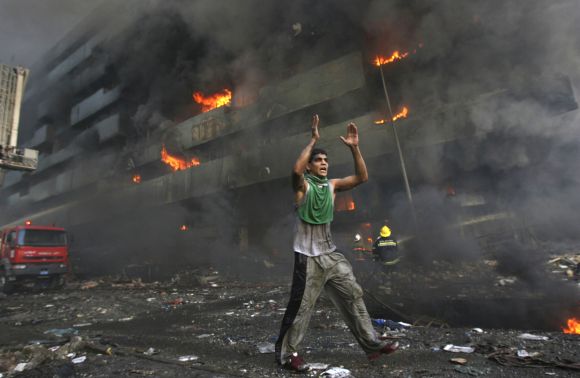
A man runs down a street warning people to flee shortly after a twin car bomb attack at Shorja market in Baghdad, on February 12, 2007.
Three bomb attacks at markets in Baghdad killed at least 64 people and wounded 150.
Photojournalist Ceerwan Aziz later writes, "When I arrived at the Shorja market where the car bomb exploded, I saw the destruction caused by the explosion of a truck laden with explosive materials. A young man cried loudly, asking people to help him in evacuating victims. His expression represented all the struggles and stories of those fallen in the attack. The picture expressed honestly the destruction and pain of the place."
Please click NEXT for More...
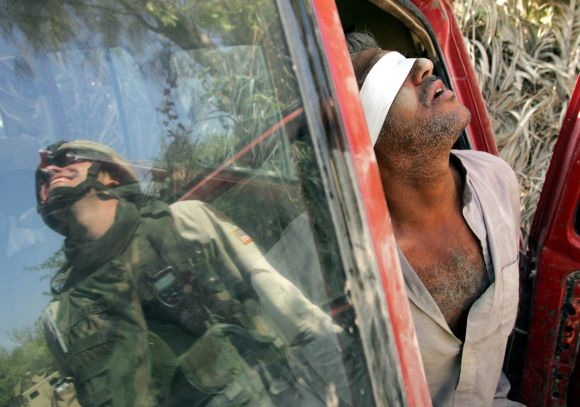
An Iraqi man suspected of having explosives in his car is held after being arrested by the US army near Baquba, on October 15, 2005.
"It was referendum day when the people would decide on the country's controversial new post-Saddam Hussein's constitution. Providing security during the historic referendum and keeping the voting stations safe was a key issue for US.-led forces in order to validate the referendum results," photojournalist Jorge Silva recalls.
"Since early morning I was on patrol with a company, visiting polling stations. The day was tense. Suddenly we ran into an old red car driving fast just in front of us. When the driver saw the army caravan, he turned around and accelerated, and a pursuit began," Silva writes.
"After some minutes of pursuit, with our vehicle almost stuck in the path the soldiers became very nervous, one of them started screaming: 'It's an ambush, it's an ambush".
"The vehicle was intercepted some 100 yards in front of us by another hummer who drove on an alternate path.
"When I reached the car, he was already being blindfold, and sitting on the back of the truck, he was praying aloud, a US captain approached him and was reflected in the window. He asked the translator what he was saying. "He's asking God to save him," the translator said. The answer triggered laughter from the soldiers. At the same time a helicopter flew over us, they turned their heads looking for it.
"The man was arrested under the accusation of having explosives in his car. But nothing was found in his vehicle. He said he didn't know anything about the ban or the referendum," the photojournalist writes.
Please click NEXT for More...
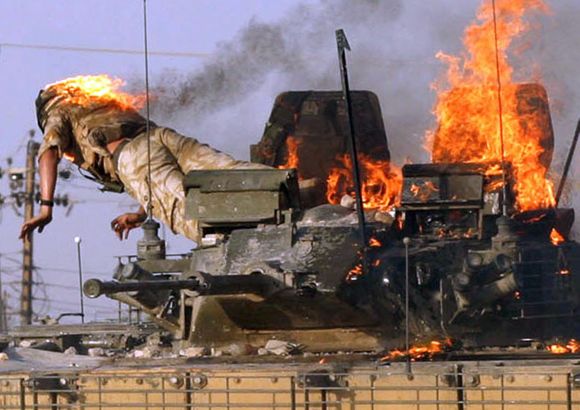
A British soldier jumps from a burning tank which was set ablaze after a shooting incident in the southern Iraqi city of Basra, on September 19, 2005.
Angry crowds attacked a British tank with petrol bombs and rocks in Basra after Iraqi authorities said they had detained two British undercover soldiers in the southern city for firing on police. Two Iraqis were killed in the violence.
Photojournalist Atef Hassan writes, "It was a tough situation following confrontations and shootings between the British army and the Mehdi Army. It was very dangerous because people were angry. I was worried and scared."
Please click NEXT for More...
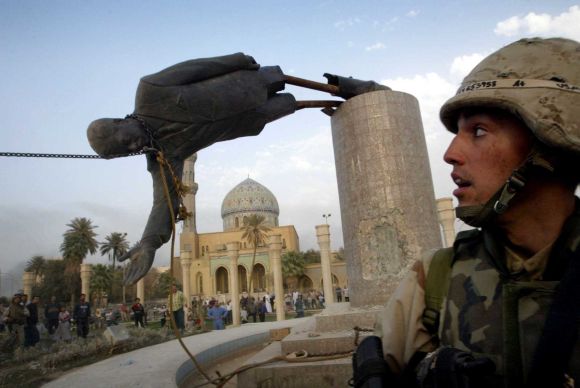
US Marine Corp Assaultman Kirk Dalrymple watches as a statue of Iraq's President Saddam Hussein falls in central Baghdad's Firdaus Square, in this April 9, 2003 photograph.
Photojournalist Goran Tomasevic writes, "Francesca, one of our London editors, called me and told me the Saddam statue was coming down. I went down there and took pictures of this guy looking at the statue. I came closer to him and had the perfect picture -- a US. Marine looking at a statue pulled down by Americans. I didn't expect this picture to be in so many publications".
Please click NEXT for More...
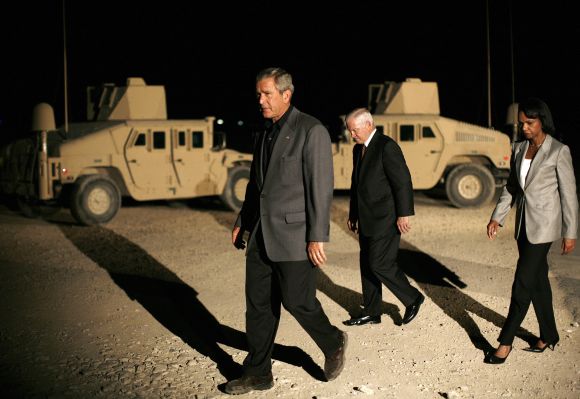
Former US President George W Bush walks in front of Humvees with then Defence Secretary Robert Gates and Secretary of State Condoleezza Rice following remarks to the press after nightfall at Al Asad airbase in Anbar province of Iraq on September 3, 2007.
Photojournalist Jason Reed writes, "This picture was taken under the cover of darkness at an airbase in Anbar province in the Iraq desert, on one of those secretive trips where you are told by a White House official to be at Andrews Air Force Base at a certain time on a particular day. No other details are given. You show up, surrender your cameras and communication devices until Air Force One is in the air, and then find out we are on a top secret trip to Iraq. No one back in Washington knew the president had even left the White House grounds until the travelling journalists with Bush broke news that we had landed at Al Asad airbase. This was really one of the only pictures that showed Bush in-country".
"My editors back in Washington and New York, who were calling and emailing for hours during our communication blackout to see if I was indeed on the trip, were relieved to see my pictures start coming in over the wires before we lifted off to Australia for the annual APEC meeting. I was more relieved when they called again to let me know that this image made the front of the New York Times, nice and big," Reed adds.
Please click NEXT for More...
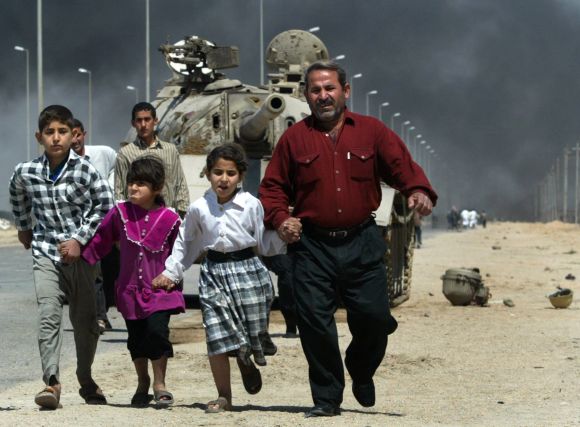
A family flees past a destroyed Iraqi T-55 tank after a mortar attack on British Army positions in the southern city of Basra on March 28, 2003.
Photojournalist Chris Helgren writes, "...On May 28 (2003) cameraman Fedja Grulovic and I were able to make it across the Zubair bridge spanning the Shatt al-Basrah waterway and into Basra's city limits. We were the first Western journalists to do so. The British army was prodding the lines on the edge of the city up ahead, sending Warrior fighting vehicles up and down a road flanking the city's technical institute. When the British got close, a barrage of mortars was unleashed by the Iraqi forces, prompting the withdrawal of the Warriors".
"Unfortunately, we and a number of civilians were also on the road. I saw a group of them running towards me and shot a few frames of this family passing a destroyed tank. Within seconds Fedja and I had to dive under the same tank, making room for an Iraqi cyclist too, as mortar shells exploded around us.
"Luckily nobody was injured, but British propaganda officers soon appeared to announce that the Iraqis were shelling their own people, neglecting to mention that the barrage was prompted by the presence of British army reconnaissance vehicles", Helgren adds.
Please click NEXT for More...

An Iraqi woman tries to explain that she has nothing to do with illegal fuel as soldiers from the 2nd battalion, 32nd Field Artillery brigade, patrol search for illegal fuel sellers in Baghdad, on August 6, 2007.
"In this picture, in a very rare interaction between civilians and soldier in those days, an Iraqi woman was trying to convince soldiers she had nothing to do with illegal fuel that was sold on the streets. They let her go," writes photojournalist Sagolj.
Please click NEXT for More...

An Iraqi detainee gestures toward US soldiers through bars of his cell at Abu Ghraib prison outside Baghdad, in this May 17, 2004 photograph.
Sagolj later writes, "Abu Ghraib and the scandal with Iraqi prisoners being tortured was probably the biggest single story after the US troops captured Baghdad. It was not the first time this prison was in the news -- it was the most notorious jail during Saddam's rule and we had already seen pictures of the execution chambers that hinted at the horror of the place. But, this was different and in my opinion, now from the distance of almost a decade, one of the most important moments that shaped the bloody war".
"Our requests to get inside the prison were swiftly refused before we could even explain why and what we want to do. Tensions were super high and fingers very nervously on the trigger. Reuters cameraman Mazen Dana was shot dead by a US soldier outside Abu Ghraib as he was filming".
"All I could do, and that proved to be right thing, was to camp at the gates of the prison complex taking some easy pictures and hoping to have a chance to get in. To my surprise, one of the visiting delegations (it was some British parliamentarians and NGOs, if I remember correctly) agreed to take me into the prison with their convoy."
"I had a few quick minutes to shoot pictures inside the prison. At one moment, as I was taking photos of empty corridors, a hand of an Iraqi prisoner came from behind the bars. I snapped a few frames," he concludes.
Please click NEXT for More...

Staff Sgt. Keith Fidler kisses his wife Cynthia, as their son Kolin looks on, during a homecoming ceremony in New York, April 8, 2011 for the New York Army National Guard's 442nd Military Police Company's return from Iraq.
"For some time I had been covering homecoming stories hoping for that picture of the soldier coming home to his or her wife and baby. This was one of those days that I went to cover the assignment hoping for that to happen and the photo God's blessed me. It was a nice moment that was genuine and worth the wait," photojournalist Shannon Stapleton writes.
Please click NEXT for More...
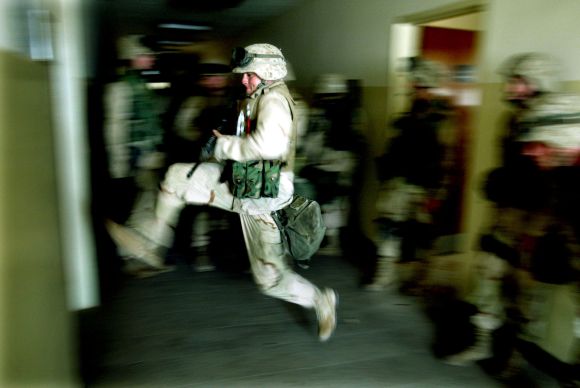
US Marines kick in a door while securing a building next to the main hospital in central Baghdad, on April 15, 2003, which will be used as a temporary Iraqi police headquarters.
"When I arrived in Baghdad, after spending a month in southern Iraq, it was still possible to go out on your own without security personnel. First I took a look at the local hospital, and after spending some time there I strolled around the premises of the hospital. I stumbled upon a group of Marines who were securing the buildings around the hospital and looking for possible collaborators or Iraqi soldiers/snipers hiding in the high rises next to the hospital. The Marines were searching the buildings thoroughly and opening each and every room by kicking in the doors".
Please click NEXT for More...
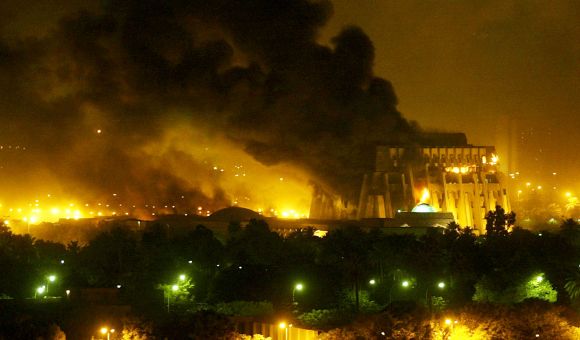
An explosion rocks Baghdad during air strikes March 21, 2003. US-led forces unleashed a devastating blitz on Baghdad on a Friday night, triggering giant fireballs and deafening explosions and sending huge mushroom clouds above the city centre. Missiles slammed into the main palace complex of President Saddam Hussein on the bank of the Tigris River, and key government buildings, in an onslaught that far exceeded strikes that launched the war the previous day.
Photojournalist Goran Tomasevic writes, "I waited all night for the first strike on Baghdad. Two nights later there was a massive bombing, and that's when I took this photo.
"I remember Iraqi troops came into the Palestine hotel, where most journalists were staying, looking for disks and tapes showing the bombing. They searched other journalists, but not me. I'm not sure why they didn't search me, perhaps because I tried to be nice to them," he adds.
Please click NEXT for More...
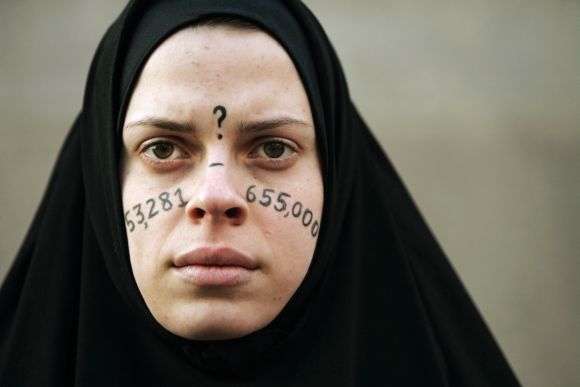
A protestor, dressed as an Iraqi civilian, stands silently at an anti-Iraq war protest in Boston, Massachusetts, on January 11, 2007. The numbers on Casilio's face represent the estimated number of Iraqi civilians killed in the war.
Photojournalist Brian Snyder writes, "I took this photograph during a protest against the Iraq conflict. The woman in the photograph is one of three women, triplets, who staged a sort of performance art piece at the event. As she explained it, the numbers on her face referred to the number of Iraqi civilians killed up to that point (a range of estimates on either cheek). For me what makes the photograph more intriguing is the question mark in the middle."
Please click NEXT for More...
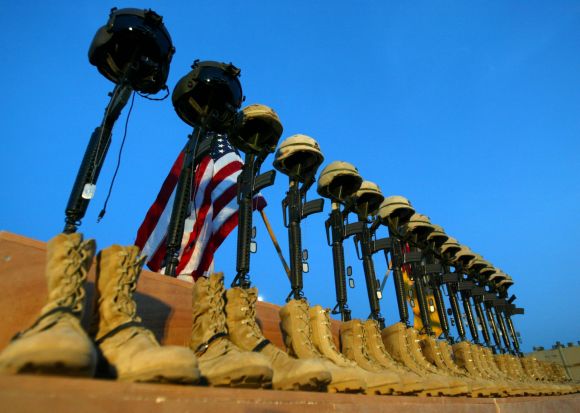
A row of US army helmets are perched on M-16 rifles during a memorial at Al Asad air base in Iraq on November 6, 2003 for the 15 victims of a Chinook helicopter which was shot down by insurgents.
Photojournalist Chris Helgren writes, "Within about six months after the fall of Saddam Hussein's regime, Iraq's occupation was getting ugly. Roadside bombs had begun to take their toll, and in early November, 2003 our bureau in Baghdad was alerted to news that a US army Chinook helicopter had crashed. Very shortly afterward it was apparent the chopper had been shot down, killing 15 soldiers and crew and wounding 26. A few days later one more of them died at a hospital in Germany.
"This was the largest single US loss of life to date in the Iraq war, and it really shook America. Three days after the crash I arrived at Al Asad air base to witness a memorial to the fallen. It was quite a sobering event, as troops quite visibly shaken formed up in front of a flatbed truck on which helmets were perched atop 15 rifles and pairs of desert boots," he adds.
Please click NEXT for More...
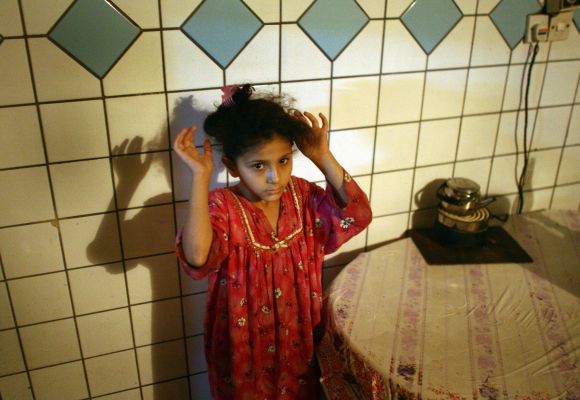
An Iraqi girl holds her hands up while US and Iraqi soldiers search her family house in Baquba, on June 30, 2007.
"During a night raid in Baquba, US oldiers searched a house they believed to be full of weapons. This girl raised her hands for a short moment as one of the soldiers entered the room. It was her immediate reaction. I try to always go in with the first soldiers as I never like to shoot pictures from the back," photojournalist Goran Tomasevic writes.
Please click NEXT for More...
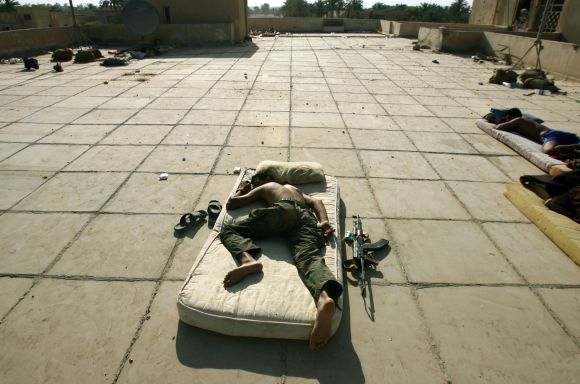
An Iraqi soldier sleeps next to his Kalashnikov rifle on the roof of a base in Baquba, on June 29, 2007.
Photojournalist Goran Tomasevic recollects, "I was on a rooftop sending pictures when I saw this soldier sleeping so I took a few frames. I remember Baquba well as I would lose 12 kilos over 3 weeks, because it was so hot. I was like a donkey --carrying 2-3 cameras, body armor, at least 3 liters of water in a camel pack and extra water bottles in my pockets. I used to carry heavy body armour as there were so many IEDs. At the end of the day you would drop everything and put on some dry clothes as yours were full of sweat."
Please click NEXT for More...
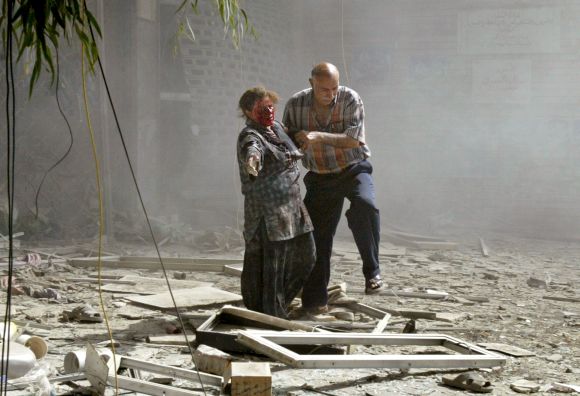
A wounded Iraqi woman is helped after several bomb attacks in central Baghdad on July 27, 2006.
Photojournalist Mohammed Ameen writes, "I headed to the scene of the blast where a building packed with explosive materials was leveled to the ground; the last thing I expected to see was a walking victim. She was covered with blood, moaning and screaming to people to help her to save the children who were stuck under the collapsed building.
"I was confused and hesitant whether to take photos or help her. In the end I had no choice but to help her after taking some pictures of the site. Unfortunately, we failed to save the children. I will not forget that tragic day forever. Dozens were killed and hundreds wounded in one of Baghdad's bloodiest days," Ameen notes.
Please click NEXT for More...

US Marines carry an injured colleague to a helicopter near the city of Falluja, on November 10, 2004.
Photojournalist Eliana Aponte recollects, "I was sitting with a crew of soldiers playing cards next to military tanks. It was a boring day with nothing to do -- just another day during my embed with the U.S. Marines from Charlie Company.
"That crew was in charge of giving water and supplies to the soldiers who were inside Falluja, where there was heavy fighting. Many people died and many soldiers were injured. They went house by house looking for rebels.
"Suddenly one mortar landed next to us, and we heard a very loud explosion. Nobody understood what happened in that moment, everybody jumped under the military vehicles. Those were scary seconds; you don't have too much time to react.
"And then after 15 seconds another one. That one landed 50 yards from us -- close enough for us to see how another crew of soldiers in front of us were blown to pieces.
"Everybody was completely paralyzed. US Master Sergeant Roy Meek from Charlie Company, screamed so loudly "This is Iraq, move!" And all the soldiers ran. I started to take pictures from where we were. They didn't let me move closer, the scene was really dramatic, Dante-esque. The only pictures were the soldiers carrying their colleagues, all of them trying to do something. The helicopters arrived so quickly. In the end, eight soldiers died -- soldiers, young people, looking for a place to work in the army, without any experience in war.
This was one of the worse days of my life. You can lose everything in just one second," she adds.
Please click NEXT for More...
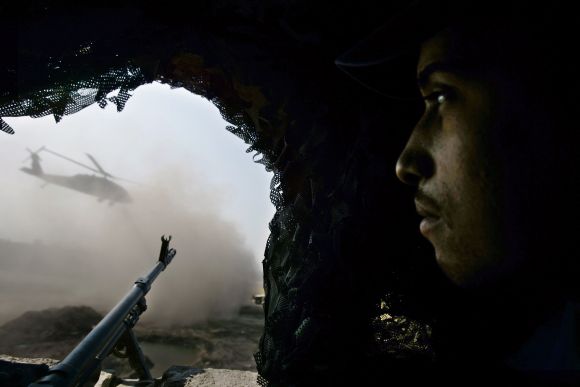
An Iraqi policeman watches a US Blackhawk helicopter leaving an Iraqi police base southeast of Baghdad, on February 14, 2007.
"This Iraqi policeman was watching a US Blackhawk helicopter leaving his base in the southeast of Baghdad. The day was very hot and a lot of the policemen in the guard towers were taking a nap. You didn't hear much more than the wind running over the desert, until this spaceship of a machine appeared, disturbing dreams," photojournalist Carlos Barria writes.
Please click NEXT for More...
...